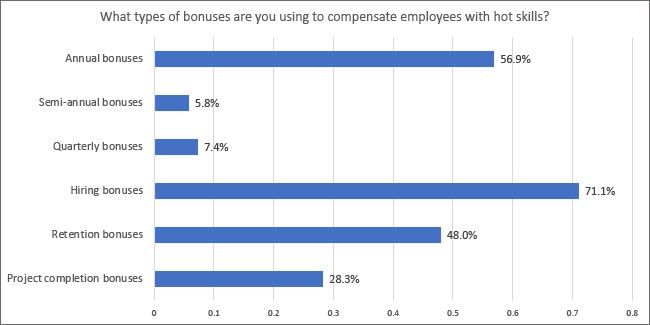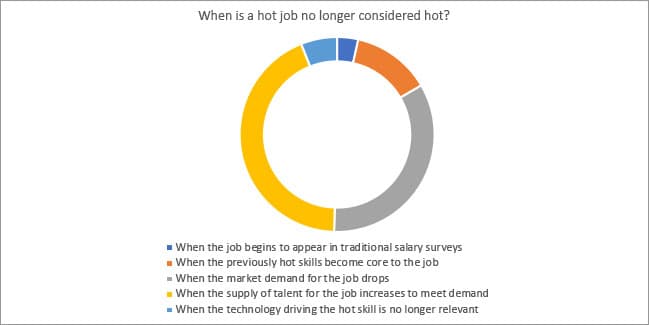Rewards Strategies for Hot Jobs
Written by Sarah Reynolds
June 17, 2019

Creating compelling rewards packages for employees in hot jobs is one of the biggest challenges facing compensation and total rewards practitioners today.
In today’s talent landscape, salaries for hot jobs are moving at a record pace, and attracting and retaining talent in these roles requires compensation professionals to keep a pulse on ever-changing market pricing. Yet for many new, emerging, and hot jobs, data is scarce or simply doesn’t exist in traditional data sources.
So how do you accurately price a job for which there is no close match, no market data, and enormous demand? And how do you create a compelling total rewards package that will maximize your ability to recruit and retain skilled talent?
Salary.com recently partnered with WorldatWork to host a webinar that looked to answer these questions – and more. Experts from our Solutions Consulting, Product Management, and Marketing teams shared best practices for pricing hot jobs, leveraging data on compensable factors to tailor your pricing efforts, and using different bonuses and incentive pay vehicles to create the most competitive offers.
As part of this webinar, we polled our live webinar audience about the strategies they’re leveraging to reward employees with hot skills, as well as how they track the movement of hot jobs in their own pay markets. Below are some of our findings from these polls.
Compensating Employees with Hot Skills
When asked how they’re currently compensation employees with hot skills, our audience members indicated that they’re currently using a variety of tactics to ensure that pay packages for these employees remain competitive.

Incorporating premiums into base salaries for these employees, a tactic used by 53.9% of our audience members, was the most common approach to compensating employees with hot skills. Whether they take the form of a skill-based premium applied to the underlying benchmark job, or a higher market percentile target used in pricing the job, these adjustments are a streamlined and effective way to meet the market demand for hot jobs and skills. And while these tactics may seem straightforward at first glance, successfully executing these pricing strategies requires a strong foundation of traditional compensation data, layered in with a deep understanding of the pricing impacts of some of today’s hottest skills.
Slotting jobs into higher grades and slotting employees into higher salary ranges were also popular tactics among our audience members, with a little more than a third of the audience indicating that they take each of these approaches. Slotting is a smart choice when data for hot jobs is scarce, as it minimizes the need for a direct job match in external market data. Instead, slotting allows you leverage the hot job’s position in your internal job worth hierarchy to inform your pricing, moving the job (or the employee) up to a higher grade as needed to keep the pricing in line with the market.
Leveraging Bonuses and Incentive Pay to Create Compelling Pay Packages
Hiring, retention, and project-based bonuses were the second most frequently used tactic for compensating employees with hot skills, with 41.2% of our audience indicating that they currently leverage some form of one-time bonus to attract and retain skilled talent. A smaller percentage of our audience (21.7%) indicated that they’re currently leveraging annual, semi-annual, or quarterly bonuses as part of compensation packages for employees with hot skills. To better understand the role that bonuses and incentive pay vehicles play in creating compelling compensation packages for skilled talent, we asked our audience to tell us a little bit more about their incentive pay strategies.

Hiring bonuses, a one-time payment made to attract employees with hot skills, were used by more than 70% of our audience, making them the most popular type of bonus in our survey. Nearly half of our audience also indicated that they’re leveraging retention bonuses, one-time payments made to encourage employees with hot skills to stay with your organization for a specific period of time, indicating that retention of these employees is just as critical as getting them in the door in the first place.
Annual bonuses, used by more than half of our audience, were the second most popular type of bonus in use, demonstrating that bonuses tied to individual, team, or company performance still play a significant role in a compelling compensation package for skilled employees. Interestingly, despite everything we’ve heard recently about how organizations are moving to more frequent awards, only a small percentage of our audience indicated that they’re currently using semi-annual or quarterly bonuses in their compensation packages for these employees.
Tracking the Lifecycle of Hot Jobs and Skills

Throughout our webinar, we discussed the need to proactively plan for what happens when hot jobs and skills are no longer hot. If you’re applying premiums to base salaries, leveraging multiple types of bonuses or incentive pay plans, and using other new tactics to compensating employees in hot jobs, it’s critical to understand how you will adjust those approaches when that hot job becomes more commonplace in the market.
But how exactly do you know when a hot job or skill is no longer hot? According to our audience, it’s all in the supply and demand equation. According to our poll, 43% of audience members believe a hot job is no longer hot when the supply for talent for that job increases to meet demand, while another 34% believe it’s when the market demand for the job drops. As the lifecycle for hot jobs shortens, it will be critical to keep a pulse not just on how the prices for hot jobs are changing in your local pay markets, but also how the demand and supply for those jobs is moving as well.


Download our white paper to further understand how organizations across the country are using market data, internal analytics, and strategic communication to establish an equitable pay structure.
Insights You Need to Get It Right









